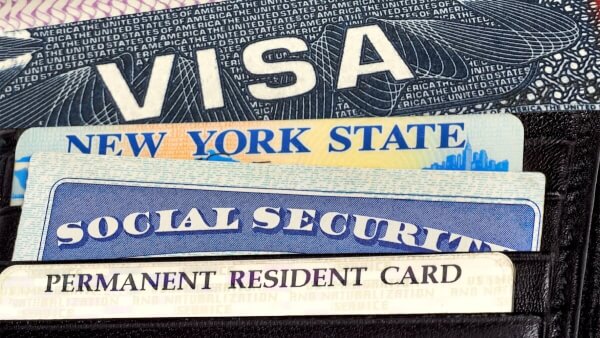Transferring your international driver's license to the US: step-by-step
Your full guide to updating your foreign driver's license to the US.

The H-1B Visa allows the holder to live and work in the US. It can often also open the opportunity to move from H-1B Visa to Green Card, with permanent resident status, further down the line.
If you’re just starting your research into moving to the US for work, get a full breakdown of the H-1B Visa here, and learn all you need to know about the Green Card in this full guide.
Ready to transition from H-1B Visa to your own Green Card? This is the guide for you. We’ll cover the full process including the fees — and also highlight how you can cut the costs of paying for your Green Card in a foreign currency, with Wise.
| 📑 Table of Contents |
|---|
To move from your H-1B Visa onto a Green Card you’ll need your employer to sponsor you. You’ll be applying for a Green Card on the basis of your employment¹, and will need to check you fit the full eligibility criteria for the work based Green Card, over on the USCIS website.
The steps you need to take to move from H-1B to Green Card are laid out in full below.
The first step in the H-1B Visa to Green Card process lies with your employer. They’ll need to get a PERM labor certification on your behalf, by submitting ETA Form 9089 to the Department of Labor², conducting a search to ensure there are no US citizens able to do the job you’re being employed for, and checking the prevailing wage for the role.
Once your employer has an approved PERM labor certification they can proceed to file Form I-140, Petition for an Alien Worker³. Your employer will have to complete this form and send it, along with the PERM certification and an evidence bundle, to make sure there is an immigrant visa available for you to apply for a Green Card.
The evidence required depends on your role and status, but will include proof your employer is able to pay you, written references from employers or trainers which shows your suitability for the role, and any available professional certifications. There’s a handy checklist by application category available online — check the documents needed for your specific application before you proceed⁴.
Once your immigrant petition has been approved you may need to wait for an immigrant visa to become available. That’s because only a fixed number of Green Cards can be issued annually, split into different employment types and countries of origin. You’ll be given a priority date, and will need to check the monthly Visa Bulletin to know when you can proceed with the next step of your application.
Once your priority date is shown in the Visa Bulletin, you’ll need to submit Form I-485, Adjustment of status⁵. This is the document that — if approved — will move your status from nonimmigrant on a visa, to permanent resident. Follow the application instructions carefully to make sure you have provided all the evidence required for your specific situation.
| Learn all about the Visa Bulletin here |
|---|
If your intention is to switch from an employment visa to a Green Card — and your company can sponsor you to do so — it’s a good idea to get started as soon as you can. There are several steps in the Green Card timeline which means the process will take time. Exactly how long depends on your situation.
As we saw above, the first step is for the employer to get PERM labor certification to allow them to proceed with the immigrant petition. This may take several months to be fully processed — and only once approved can the immigrant petition be submitted. If the PERM certification is subject to an audit the process will be extended even more.
However, the longest wait for some people is yet to come. If you’re from a country with high immigration to the US and need to wait for an immigrant visa to become available, your wait could be several years. To put this in context, in the July 2021 Visa Bulletin, although there are visas available for all First Preference workers, if you fall into the Second Preference category and come from India, you’ll have something in the region of a 10 year wait to get your visa. Candidates from mainland China who are now at the front of the visa line have been waiting since 2017, too.
Check out the visa bulletin for your employment type and home country, to see how long this wait period may last⁶.
Once a visa is available you can submit your full application for your employment based Green Card. This may take several more months to be processed, and will depend on the specific location of filing. You’ll be able to check out the wait times by location, and track your case as it progresses, online⁷.
In short: start your Green Card application as soon as possible to avoid the frustration of needing to extend your H-1B visa over and over again.
There’s no pre-set wait time before you can apply to adjust your status from H-1B Visa to Green Card. The sooner you start, the sooner your application could be processed — so it’s wise to begin as soon as your employer agrees to act as your sponsor.
If you wait until after your H-1B Visa has expired before applying for the Green Card your application is likely to be rejected and you may face penalties for being illegally in the US.
Ideally you’ll have applied for your Green Card prior to your H-1B Visa status expiring. However, if you find yourself ‘out of status’ you’ll need to apply to USCIS to extend your stay, using Form I-539⁸. To qualify you’ll need to explain why you didn’t extend or change your status earlier — including the exceptional circumstances which led to the delay.
If you’re in the process of getting a Green Card, and your I-140 form was filed a year prior to the usual 6 year limit for your H-1B visa, you’ll be able to extend your visa for 1 year at a time. This is to allow your Green Card application time to be processed.
There are several fees to pay when applying for a Green Card from H-1B status. Federal law requires that the first of these costs, the PERM fees, are covered by the employer⁹. However, the filing fees for the next 2 steps — Form I-140 and Form I-485 — can be paid by either employer or employee. The filing fees are as follows:
- Form I-140: 700 USD
- Form I-485: 1,140 USD
Before you start the H-1B to Green Card process you’ll need to negotiate with your employer who covers the costs. There may be other fees to consider, too. If you’re applying for dependents to move to the Green Card at the same time, there will be additional costs involved when filing applications on behalf of your family members.
You may also incur fees when putting together your evidence pack to support your application. This may include the fees to translate or notarize documents for example.
If you’re paying your Green Card fees from a foreign currency, check out Wise for low cost international transfers. You’ll be able to transfer funds from your overseas bank account into USD for a low, transparent fee — and you’ll know there are no hidden costs to worry about.
|
|---|
Save on international transfers
Unfortunately there are several reasons why your Green Card application may not be approved. These could apply at any stage of the application process, from the PERM labor certification to the different petitions and applications required after that.
If your application is denied, you’ll receive a written notice stating why — and also telling you what your options are from that stage. You may be able to appeal or file a motion to reopen the case. If you think the case has been wrongly judged and have strong evidence to back up your points, reopening the case may be a good option. Submitting an appeal will result in your case being reviewed at a higher level¹⁰.
If you reach this stage you might need the help of a specialist immigration lawyer. Take professional advice to give yourself the best chance of success.
If you’re already in the US for work, and hold your H-1B Visa, then adjusting your status to Green Card holder may be an obvious move. You’ll then have the permanent right to reside in the US and could work in different roles without needing to reapply for your visa.
Immigration processes can be daunting and complex. Use this guide to help you understand your options and the route you need to follow based on your situation. And don’t forget to check out Wise and the Wise Multi-currency Account when you need to send, receive, or hold foreign currencies.
Sources:
Sources checked on 04.08.2021
*Please see terms of use and product availability for your region or visit Wise fees and pricing for the most up to date pricing and fee information.
This publication is provided for general information purposes and does not constitute legal, tax or other professional advice from Wise Payments Limited or its subsidiaries and its affiliates, and it is not intended as a substitute for obtaining advice from a financial advisor or any other professional.
We make no representations, warranties or guarantees, whether expressed or implied, that the content in the publication is accurate, complete or up to date.

Your full guide to updating your foreign driver's license to the US.

Whatever your reason is for moving to the US, this guide aims to help you figure out the most important costs you'll face when you live there.

Find all you need to know about getting a personal loan for H-1B visa holders in this guide.

Everything you need to know about the US certificate of naturalization.

The US welcomes large numbers of new arrivals every year — and getting a great job to both gain experience and set down roots is a core part of the American...

Find everything you need to know about the US citizenship test, including the USCIS questions and answers.